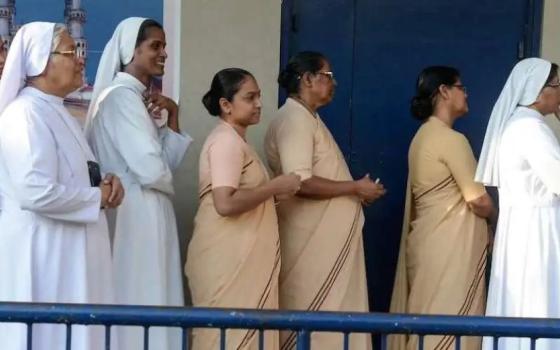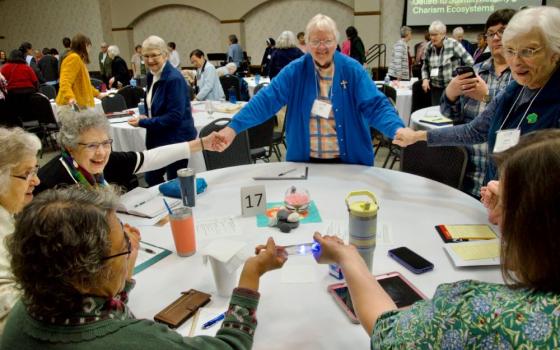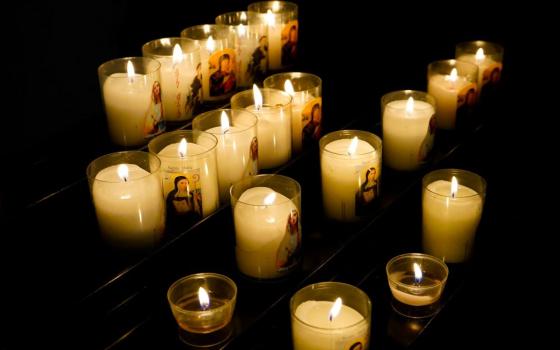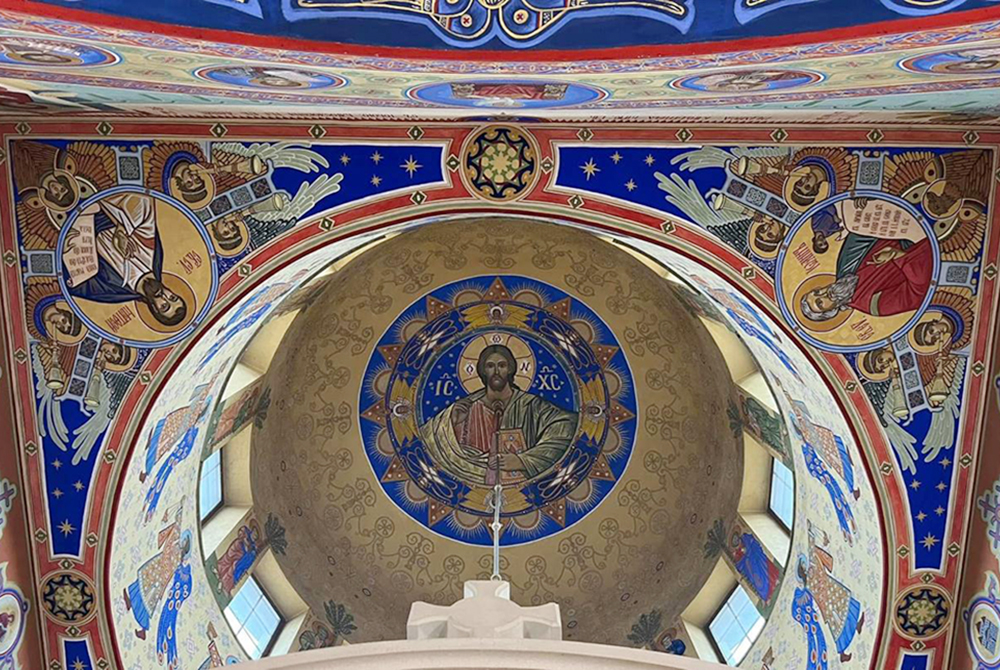
Christ Pantocrator, surrounded by the four Evangelists, depicted inside the Church of The Entry of the Most Holy Theotokos into the Temple in Zhytomyr, Ukraine. (Courtesy of Emanujila Vishka)
This spring, I visited Zhytomyr, a city in Ukraine founded in the ninth century, around the same time as the invention of gunpowder in China and algebra in Baghdad. Zhytomyr is as old as Beowulf and Alfred the Great, the first king of the English.
Unfortunately, Zhytomyr's location did not allow it to preserve all its historic landmarks, such as a medieval castle, churches and monasteries. The city has been destroyed and burned to ashes by various invaders many times, only to be rebuilt again and again by its perseverant citizens.
Advertisement
My first impression in March 2024 emerged from the city's poorest slums, where the prevailing dirty gray color of an industrial zone set a somber tone. It was in this area that the Basilian Sisters founded their monastery two decades ago. The dominance of gray, a result of Soviet and earlier Russian imperial policies, casts a depressing mood over a city buried under concrete and asphalt. Nothing lifts the spirit. Nothing catches the eye with beauty.
Then, suddenly, amid the dilapidated huts and factory chimneys passing by my car window, a neat white brick church and monastery appeared. Yet nothing prepared me for the experience inside the church. I would call it a colorful shock — a rich rainbow palette that transports visitors into a fairy-tale world. The eye is drawn into Byzantine blue and carmine red, golden orange and bronze, following the joyful yet solemn beauty in circles and waves. By the end of the visit, the gray dominance of Zhytomyr's slums is replaced in one’s consciousness by the radiant and vibrant church interior.
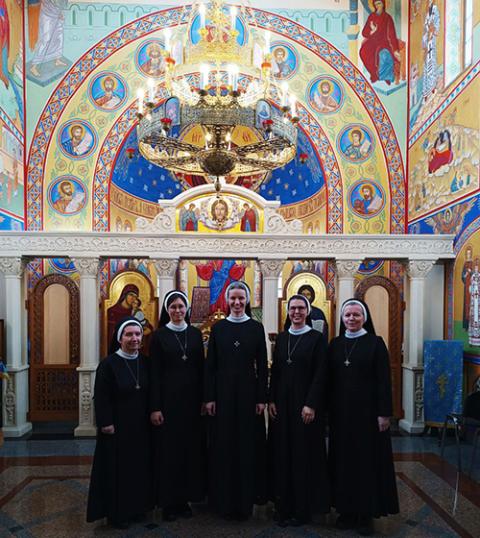
Sr. Emanujila Vishka in the center with visitors from the General Administration and other members of the Basilian Sisters community inside the Church of The Entry of the Most Holy Theotokos into the Temple in Zhytomyr, Ukraine. The visit was part of a canonical visitation in March 2024. (Courtesy of Emanujila Vishka)
The frescoes of the monastery church were created by the Basilian Sisters: Sr. Nazaria Mykhayliuk, along with Srs. Dia Zahuska, Yevstakhiya Romanchuk, Mykhaila Kindra, Khrystofora Ternynko, Romana Hutnyk, Yelysaveta Varnitska and Yakynta Hulkovska. I do not know whether it was the sisters' intuition, a miraculous coincidence, or a carefully prepared plan, but for the people of Zhytomyr, this monastery church is like a vitamin for a nutrient-deficient body.
Ascetism in architecture speaks loudly amid the roller coaster of bright images in advertisements, online videos, movies and TV shows. But when dull gray dominates the environment, people searching within themselves need icons that quench their thirst for joyful color and variety. The sisters worked for several summers to paint the church walls, and although one part remains unfinished, the impression it leaves is stunning.
Praying there, surrounded by beauty that immediately embraces every visitor, is an experience I highly recommend. Considering the war, the ever-present threat of invasion, and the possibility of being erased as a nation, places like this have profound therapeutic significance for the people of Zhytomyr and all of Ukraine. The walls of this monastery are not the only refuge that citizens of Zhytomyr can find in this particular place.
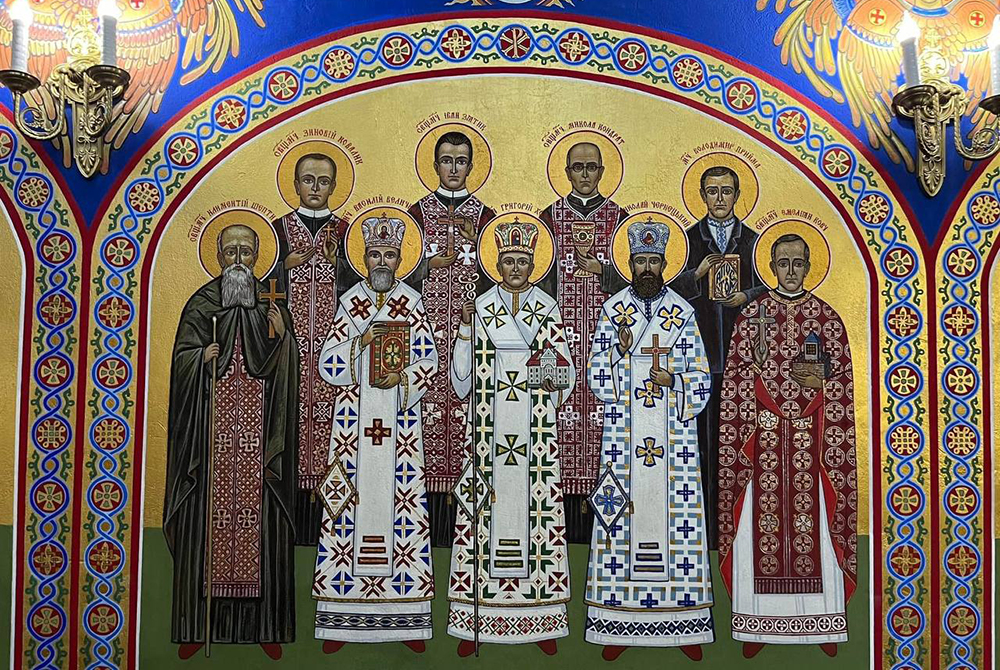
An icon depicting Ukrainian martyrs — bishops, priests, and laity of the 20th century — who were beatified in 2001. The first row, from left: Klymentiy Sheptytsky, Vasyl Velychkovsky, Hryhoriy Khomyshyn, Nicholas Charnetsky, and Omelyan Kovch. The second row, from left: Zynoviy Kovalyk, Ivan Ziatyk, Mykola Konrad, and Volodymyr Pryjma. (Courtesy of Emanujila Vishka)
The mission of the Basilian Sisters in Zhytomyr mirrors the spirit of their church interior. Their prayerful, healing and life-giving presence is a source of nourishment for the soul. Currently, the community consists of three sisters who serve in education, health care, social care and pastoral ministry. Next year, the Basilian Sisters will celebrate 20 years since their arrival in Zhytomyr. I can personally testify that this joyful community faithfully serves the marginalized and anyone in need.
Perhaps the best way to describe them is as keepers of hope — a hope that the Basilian Sisters and their predecessors have safeguarded for centuries, through all the turbulence of Ukrainian history. Despite the forces of darkness and the looming shadows of despair, I wholeheartedly wish for this community and their beautiful church to persevere in hope and to triumph in the love and joy they share with the people of Zhytomyr.

